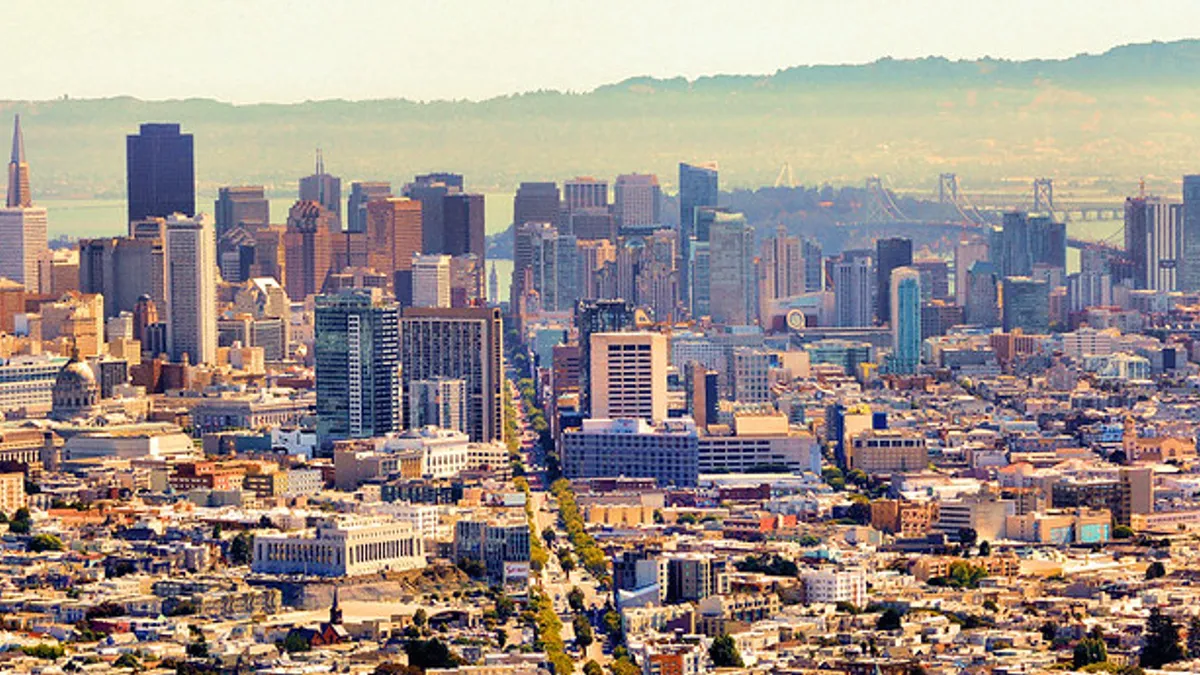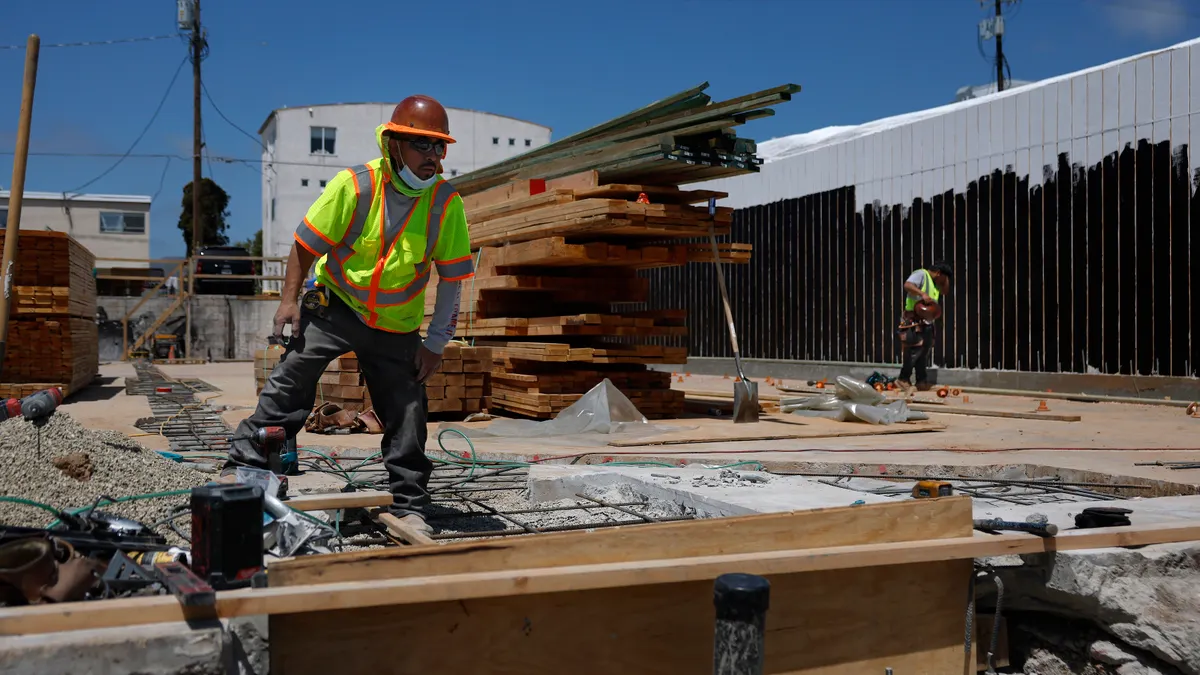Editor's Note: The following is a guest post from Rachel Keeney and Eamon Welch of Goodwin's Real Estate Industry Group.
The 1853 sale of Elisha Otis' first elevator with a patented safety brake arguably transformed the world.
As an early example of real estate technology or "PropTech," the elevator single-handedly facilitated the densification of urban areas. No longer would cities have to expand "out"; they could now soar "up." This development quite literally shaped the configuration of urban geographies over the last 167 years and continues to do so today.
Paradoxically, in the COVID-19 era, a technology that contributed so much to the physical composition of the metropolitan landscape has become its Achilles' heel. Given that modern cities are predicated on verticality, they cannot practically operate without an efficient elevator infrastructure. Accordingly, as the U.S. begins to reopen its economy, minimizing the health and safety concerns entwined with elevator usage is imperative to renewing the functionality and vitality of urban centers.
In light of the pandemic, we've outlined six recommendations for owners and operators of vertical real estate assets to consider in mitigating elevator-related health concerns. The commercial real estate industry must strategically resolve these issues, or risk debilitation until widespread availability of a COVID-19 vaccine.
1. Reduced crowd density in elevator lobbies
The first challenge to mitigating the transmission of COVID-19 materializes before an individual even enters an elevator, as crowds often congregate in lobbies at peak arrival and departure times. This dynamic, if left unaddressed, creates an atmosphere where COVID-19 could proliferate.
By now, the phrase "social distancing" is ingrained in our collective mind as one of the most effective ways to reduce COVID-19's spread. Accordingly, incorporating and enforcing proper physical spacing of six feet or more between individuals is a measure that all commercial buildings should consider in their elevator lobbies.
In order to make this approach viable, reducing the amount of people waiting on an elevator at any given time is imperative. Owners and operators can accomplish this objective by staggering arrivals/departures and elevator usage times generally and by encouraging the minimization of non-essential rides.
2. Touchless access
Given that traces of COVID-19 can linger on surfaces for hours, or in some cases, days, vendors are laboring to repurpose the way people summon elevators. Touchless elevator access will play a crucial role in reinvigorating foot traffic between the various asset classes in urban areas.
From mobile applications that allow users to communicate with an elevator to schedule rides and floor destinations in advance, to holographic and contactless interfaces that enable users to select elevator buttons without actually touching any physical surface, there are a variety of touchless access products (and related product costs) that are already available in the market or currently in the works.
Other devices that eliminate direct contact with elevator surfaces include elevator buttons that can be activated with kick pedals; voice commands; hand gestures; and facial recognition technology that is able to identify a rider and that rider’s floor destination. Pairing these technologies with destination dispatch — a tool that optimizes elevator traffic in multi-elevator buildings by grouping passengers who have common or similar destinations together — can also reduce crowding in elevator banks and elevator ride times.
3. Self-cleaning elevator button covers
Countless older buildings were constructed prior to, or otherwise without, touchless elevator systems. Depending on the age and structure of those buildings, repurposing them with touchless capabilities could prove architecturally impractical or cost prohibitive.
Fortunately, owners and operators of these buildings can consider other PropTech solutions to minimize the potential transmission of COVID-19 on a surface subjected to frequent contact by numerous individuals on a daily basis.
One compelling solution is self-cleaning elevator button covers. These covers are powered by light and continuously disinfect their surface through an oxidation process, thus decreasing the risk of COVID-19 transmission through physically pressing elevator buttons. The covers require replacement only about every two to three months, so from an operational standpoint their installation and maintenance is not unduly cumbersome.
4. Elevator riding protocol
Similar to elevator lobbies, limiting the maximum capacity of each elevator ride in order to ensure proper social distancing is an important and simple consideration for owners and operators of vertical properties. This can be complemented with the installation of elevator markings indicating where each rider should stand while being transported to a particular floor.
Mandating masks during elevator rides is another measure that could help mitigate transmission of COVID-19. And as awkward and draconian as it may appear, prohibiting talking in elevators and asking individuals to face the walls during rides could lower transmission rates in a statistically significant fashion.
Finally, establishing rules prohibiting riders from leaning against or otherwise touching any surface in an elevator (to the extent practical) will also serve to limit the possibility of COVID-19 transmission from physical contact.
5. Upgraded air filtration systems
Adding or modernizing an elevator car purifier is another means of reducing the risk of virus transmission between riders. Air purifiers minimize the spread of droplets and aerosols (such as dust) by circulating the air within an elevator car through a disinfection and purification process.
Automated air cleaning systems can eliminate bacteria, disinfect surfaces, filter germs and ultimately add an extra layer of cleanliness to elevator cars. Purifiers also block air pollutants and other harmful air particles, thereby promoting safety and comfort among riders.
6. Elevator sanitation systems
Although air purification is an important element of minimizing the transmission of COVID-19, it does not solve the protective equation entirely. COVID-19 can persist on physical surfaces for days. And while procedures such as dissuading riders from leaning on or otherwise touching surfaces can help, rider contact with elevator surfaces is inevitable.
Certain PropTech innovations are attempting to mitigate — or even eliminate — this vulnerability. Through the utilization of germicidal UV-C light, many smart elevator companies have created elevator disinfectant systems that purports to destroy all surface and airborne virus and bacteria in an elevator. These systems employ infrared technology to detect when humans are not present in the elevator, and only need to run for 10-15 minute intervals in order to sanitize.
Although the pandemic has disrupted many of the efficiencies derived from elevator use and created novel issues around how this infrastructure should be responsibly managed, the elevator will continue to play a pivotal role in providing access to vertical real estate assets. As pandemic-related guidelines, cleaning protocols and PropTech innovations continue to evolve, so too will the way individuals interact with elevators and other members of their community.
Until a successful COVID-19 vaccine is widely available, the commercial real estate industry will need to continually reassess the myriad of available options designed to provide greater levels of safety, comfort and confidence among building occupants and visitors.


















